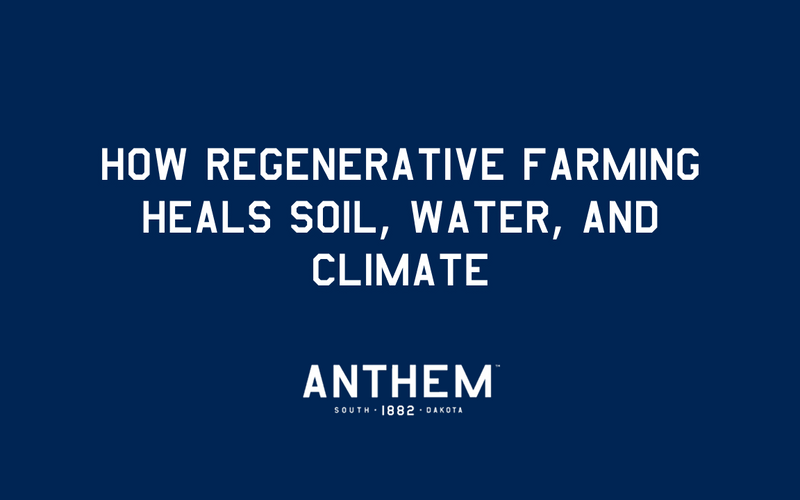
After decades of industrial agriculture, farmers around the world are rediscovering something their great-grandparents knew instinctively: healthy farms work with nature, not against it.
Today, our commitment to regenerative farming represents both a return to these time-tested principles and an embrace of modern scientific understanding. Rather than depleting natural resources, regenerative agriculture actively restores them.
The approach focuses on rebuilding soil health, enhancing biodiversity, and creating farming systems that can actually help reverse climate change while producing nutritious food.
Building Living Soil
Healthy soil forms the foundation of regenerative farming and everything we do at Anthem Oats. Unlike conventional agriculture that treats soil as an inert growing medium, regenerative practices recognize soil as a complex living ecosystem. This underground world contains billions of microorganisms that work together to cycle nutrients, store carbon, and support plant health.
Our family farm dedicates acres exclusively to oats, using carefully planned crop rotations that protect and enrich soil health. These rotations not only prevent cross-contact with other grains, ensuring the purity you taste in every bowl of our Old Fashioned Oats, but also feed the diverse community of beneficial microbes that make our soil so productive.
Conventional farming often disrupts these soil communities through intensive tillage, synthetic fertilizers, and pesticides. Over time, this leads to soil degradation, erosion, and reduced fertility. Regenerative farmers like us take a different approach, using practices like cover cropping, composting, and minimal tillage to feed and protect soil organisms.
The results speak for themselves.
Our regenerative soils contain more organic matter, hold water better during South Dakota's unpredictable weather, and resist erosion during heavy rains. They also sequester significant amounts of carbon from the atmosphere, turning our oat fields into carbon sinks rather than sources of greenhouse gases.
Water: Nature's Most Precious Resource
Water management is where regenerative farming truly shines, and it's especially crucial on the Great Plains where we grow our oats. Healthy soils with high organic matter can hold up to 20 times their weight in water, like a giant underground sponge. This means our regenerative farm needs less irrigation and remains resilient during both droughts and the severe weather events that have become more common in our region.
Traditional farming practices often create compacted soils that can't absorb rainfall effectively, leading to runoff that carries away precious topsoil and creates pollution in waterways. Our regenerative practices improve soil structure, allowing water to infiltrate deeply and reducing erosion by up to 90% compared to conventional methods.
This water retention directly impacts the quality of our oats. When plants have consistent access to soil moisture and nutrients, they develop better flavor profiles and higher nutritional content. That's part of why our Steel Cut Oats and instant oatmeal cups deliver such rich, satisfying taste, the oats are simply healthier from the ground up.
Climate Solutions Growing in the Ground
Perhaps the most exciting aspect of regenerative farming is its potential to help address climate change. Through photosynthesis, our oat plants pull carbon dioxide from the atmosphere and, with the help of soil microbes, store it underground as soil organic matter. Every acre of our regeneratively managed oat fields actively works to remove carbon from the air.
Research shows that regenerative practices can sequester substantial amounts of carbon—some studies suggest that widespread adoption could offset a significant portion of global agricultural emissions. Unlike many climate solutions that require massive technological investments, carbon sequestration through regenerative farming happens naturally when we work with ecological processes.
Our 100% USA-based supply chain also reduces transportation emissions, while our regenerative practices create oat crops that are naturally more resilient to weather extremes, ensuring a stable supply of quality oats for your breakfast table.
From Healthy Soil to Your Bowl
The connection between regenerative farming and food quality becomes clear when you understand how soil health affects plant nutrition. Oats grown in biologically active, mineral-rich soil develop higher levels of protein, fiber, and essential nutrients. They also express more complex flavors that come through in the final product.
At Anthem Oats, we mill our oats with a light touch to preserve their natural nutrition and flavor. When you pour a bag of our Old Fashioned Oats or prepare one of our convenient oatmeal cups, you're getting oats that reflect five generations of careful soil stewardship. The difference is noticeable. In taste, texture, and nutritional value.
Our commitment to keeping oats pure starts in the field with dedicated oat acreage and continues through harvest and processing with equipment and storage practices designed to maintain quality. It's a holistic approach that honors both the land and the harvest, ensuring that what reaches your table is as close to nature's original design as possible.
Supporting the Regenerative Movement
Consumer choice drives agricultural change. Every purchase is a vote for farming systems that heal the planet while producing nutritious food.
The transition to regenerative agriculture isn't always easy for farmers. It requires learning new techniques and often involves short-term financial challenges as ecosystems restore themselves. However, many farmers find that regenerative systems become more profitable over time as input costs decrease and soil health improves.
As more consumers seek out regeneratively grown products, we create market demand that makes regenerative farming financially viable for more producers. This is how food systems change: one conscious purchase at a time.
The beauty of regenerative farming lies in its elegant simplicity. By working with natural systems instead of against them, we can produce abundant, nutritious food while actually improving the environment. In a world facing climate change, soil degradation, and water scarcity, regenerative agriculture offers both hope and practical solutions growing right beneath our feet, and right in your breakfast bowl.


